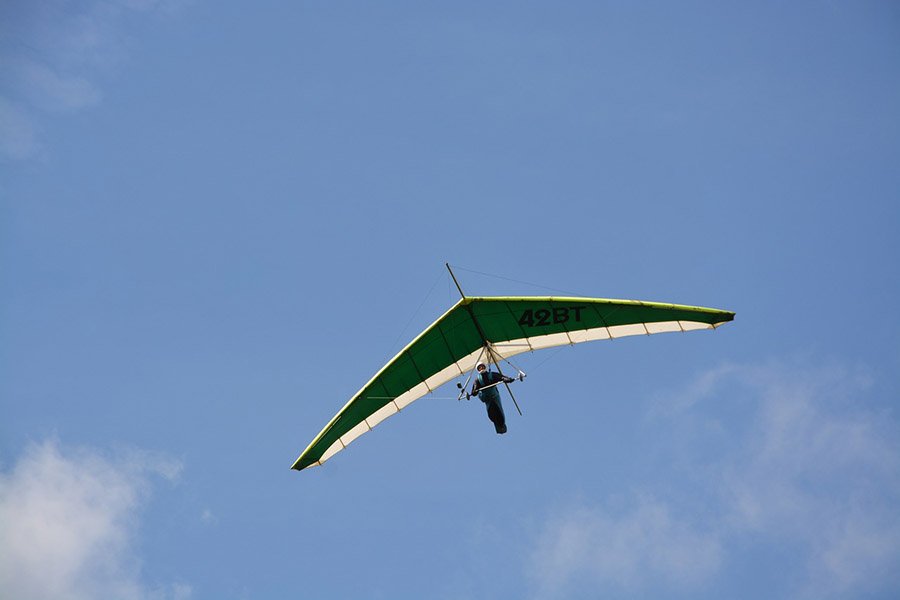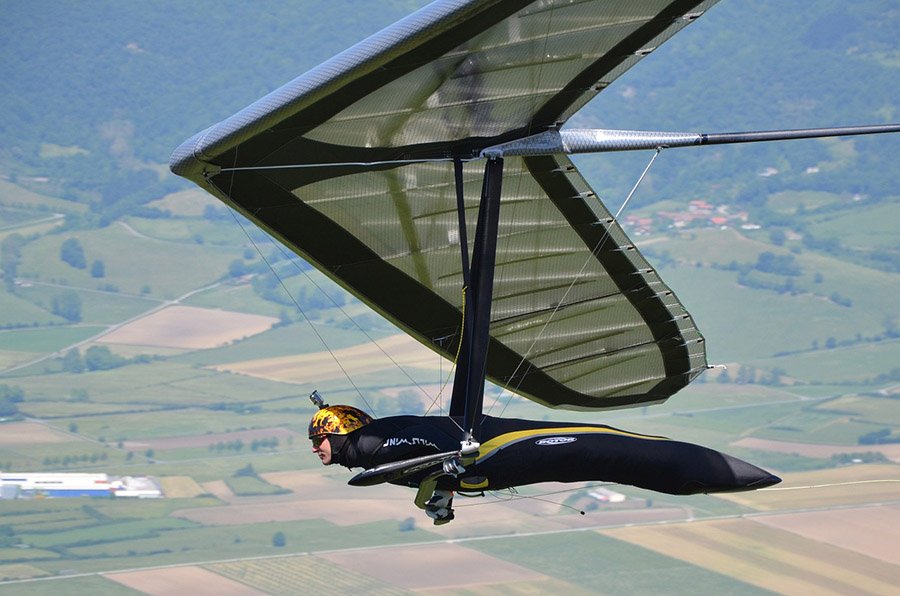Paragliding vs. Hang Gliding: Major Differences and Which to Choose?
There’s nothing quite like soaring through the skies, the wind rushing past you as the world unfolds beneath your feet. Aerial sports such as paragliding and hang gliding have captivated adventurers for decades, offering a unique blend of freedom, adrenaline, and connection with nature.
While both sports involve unpowered flight, they differ in equipment, techniques, and the experience they offer. Whether you’re a thrill-seeker or someone looking to enjoy serene, panoramic views, choosing between paragliding and hang gliding can feel overwhelming. This guide breaks down the key differences, helping you decide which one might be your perfect match.
What Are Paragliding and Hang Gliding? (Equipment and Design)
Paragliding
Paragliding equipment revolves around a flexible, lightweight wing that resembles a parachute. This wing, also called a canopy, is connected to the pilot by a series of suspension lines and a harness. The harness provides comfort and control, allowing the pilot to sit upright or slightly reclined while flying.
One of the standout features of paragliding is its portability. The entire setup can be folded and packed into a large backpack, making it easy to carry around. This makes paragliding a convenient choice for adventurers who want minimal hassle when transporting their gear.
Hang Gliding
In contrast, hang gliding uses a rigid, delta-shaped wing made of a sturdy aluminum or carbon frame covered with fabric. The pilot is suspended in a prone position within a harness, lying face-down for optimal aerodynamics and control.
However, this robust design comes with added bulk. Hang gliders are not as portable as paragliders and typically require a vehicle for transport. Despite the added effort, the sleek structure allows for higher speeds and a more dynamic flying experience.
Also read: Paragliding vs. Parasailing: How Do They Compare?

Launch and Takeoff Techniques
Paragliding
Paragliding launches typically involve running downhill on a slope or taking off from a mountain. As the pilot runs, the canopy inflates with air, creating lift and allowing the pilot to take flight. For flat terrains, a winch system can be used to tow the paraglider into the air.
The process is straightforward, and with proper training, most beginners can master basic takeoff techniques quickly. The gentle and forgiving nature of the takeoff also makes it a popular choice for first-timers.
Hang Gliding
Hang gliding launches are similar but require a bit more physical effort. Pilots run downhill with the glider strapped to their harness, using the wing’s rigid frame to generate lift. This method demands more strength and coordination than paragliding takeoffs.
For those flying in areas without hills or mountains, aerotow launches are an alternative. A powered aircraft tows the hang glider into the sky, releasing it at a suitable altitude. While more complex, these techniques open up more possibilities for hang gliding enthusiasts.
Flight Experience and Maneuverability
Paragliding
Paragliding offers a serene and peaceful flight experience, ideal for those who enjoy taking in panoramic views of the surrounding landscape. The slower speeds of a paraglider make it feel more relaxed, allowing you to savor the moment while navigating the skies. The wing is highly sensitive to air currents, enabling tight turns and graceful maneuvers.
While paragliders are not designed for extreme aerobatics, advanced pilots can perform controlled tricks, adding a touch of thrill to their flights.
Hang Gliding
Hang gliding, on the other hand, delivers a more dynamic and adrenaline-packed experience. Thanks to its rigid frame and streamlined design, a hang glider can achieve much higher speeds than a paraglider. This makes hang gliding a popular choice for thrill-seekers who enjoy the rush of cutting through the air at exhilarating velocities.
The higher responsiveness of the controls also allows for impressive aerobatic maneuvers, such as loops and dives. However, these require advanced skills, making hang gliding more challenging for beginners.

Safety Considerations
Paragliding
Paragliding’s slower speeds generally result in softer landings, which can be an advantage for less experienced pilots. However, paragliders are more sensitive to weather conditions, particularly strong winds and turbulence. Sudden changes in weather can lead to instability, so understanding meteorology and choosing the right flying conditions are critical for safety.
Additionally, the lightweight and flexible structure of the canopy provides minimal protection in the event of a crash, emphasizing the importance of proper training and risk management.
Hang Gliding
Hang gliders, with their rigid frames, are better equipped to handle moderate turbulence, offering more stability during flight. However, the higher speeds involved in hang gliding can lead to more severe impacts in the case of a crash.
The sport also requires more physical strength to manage the glider during launch and landing, which can increase the risk of injury for those who lack sufficient training or preparation. Regardless of the sport, adhering to safety protocols and learning from certified instructors are key to minimizing risks.
Learning Curve and Accessibility
Paragliding
Paragliding is often praised for its relatively short learning curve. The equipment is lightweight and easy to handle, and the basic techniques of launching, steering, and landing can be learned within a few days of training. The physical demands are also lower, making it more accessible to a wider range of people, including those who may not have high levels of physical fitness.
This accessibility makes paragliding a popular choice for beginners or those looking for an approachable entry into the world of unpowered flight.
Hang Gliding
In contrast, hang gliding has a steeper learning curve. The heavier and more complex equipment requires more time to master, particularly when it comes to launching and landing. Pilots also need to develop greater upper body strength and coordination to control the glider effectively.
While this can be a barrier for some, the rewarding experience of mastering hang gliding often appeals to those who enjoy a challenge and are willing to invest time and effort into the sport.

Cost and Maintenance
Paragliding
Paragliding is generally more affordable compared to hang gliding. The equipment itself, including the wing, harness, and safety gear, comes at a lower cost. Additionally, the portability of the setup eliminates the need for specialized transportation, reducing ongoing expenses.
Maintenance for paragliding gear is straightforward. Regular inspections of the canopy, lines, and harness are necessary to ensure safety, but the lack of a rigid frame means fewer parts to repair or replace.
Hang Gliding
Hang gliding involves a higher initial investment. The rigid wing structure and frame contribute to the increased cost, and transportation often requires a suitable vehicle, adding to the expenses.
Maintenance is also more complex, as the rigid frame and aerodynamic components need regular checks for wear and tear. However, the durability of hang gliders can make them a long-term investment for dedicated enthusiasts.
Popular Locations and Communities
Paragliding
Paragliding is practiced worldwide, with countless scenic locations catering to this sport. Popular sites include the French Alps, the beaches of Brazil, and even urban takeoff points like Cape Town’s Lion’s Head. Many locations provide easy access to hills or mountains, making it a versatile option.
The paragliding community is large and welcoming, with schools and clubs offering beginner lessons, gear rentals, and opportunities to connect with fellow enthusiasts.
Hang Gliding
Hang gliding also boasts a global presence, with iconic spots such as the cliffs of Rio de Janeiro, California’s Torrey Pines, and Australia’s Stanwell Park drawing pilots from around the world. However, the need for higher altitudes or towing facilities makes some locations less accessible.
The hang gliding community is smaller but tightly knit, offering a sense of camaraderie among pilots. Local clubs often organize events, competitions, and group flights, making it easier for newcomers to find support.

Which is Best for You?
For Adventure Seekers
If you’re drawn to high speeds, aerobatic maneuvers, and a more dynamic experience, hang gliding may be your ideal match. It’s perfect for those who enjoy physical challenges and don’t mind investing more time and effort into mastering the sport.
For Relaxed Explorers
For those who prefer a peaceful, scenic flight and easier logistics, paragliding is the way to go. It’s beginner-friendly, less physically demanding, and better suited for travelers who prioritize convenience.
Consider Your Location
The availability of training schools and flying sites in your area can also influence your choice. If you live near hills or mountains, paragliding might be more practical. Conversely, hang gliding enthusiasts often have to travel farther to find suitable locations.
Budget and Commitment
If you’re on a tighter budget or looking for a less gear-intensive activity, paragliding is the more economical option. Hang gliding is better suited for those ready to make a more significant investment in equipment and training.
Conclusion
Both paragliding and hang gliding offer exhilarating ways to experience the freedom of unpowered flight. While paragliding shines in its simplicity, accessibility, and tranquil experience, hang gliding stands out with its speed, precision, and adrenaline-pumping maneuvers.
Ultimately, the best choice depends on your preferences, physical abilities, and the type of flying adventure you’re seeking. Whichever path you take, both sports promise unforgettable moments in the skies, connecting you with nature in a way few other activities can.





